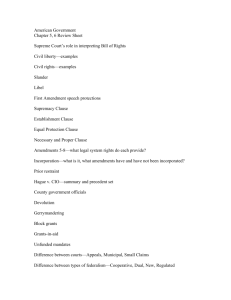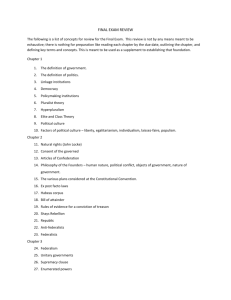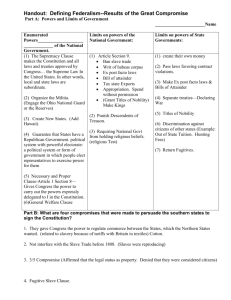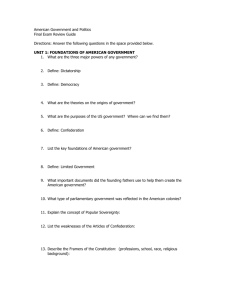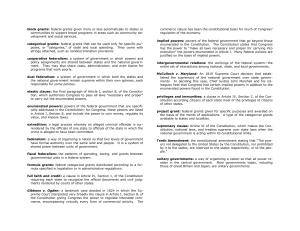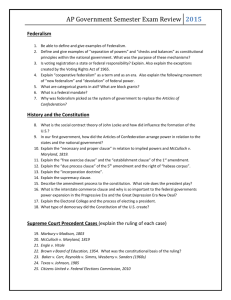Chapter 3: Federalism - Saugerties Central School
advertisement
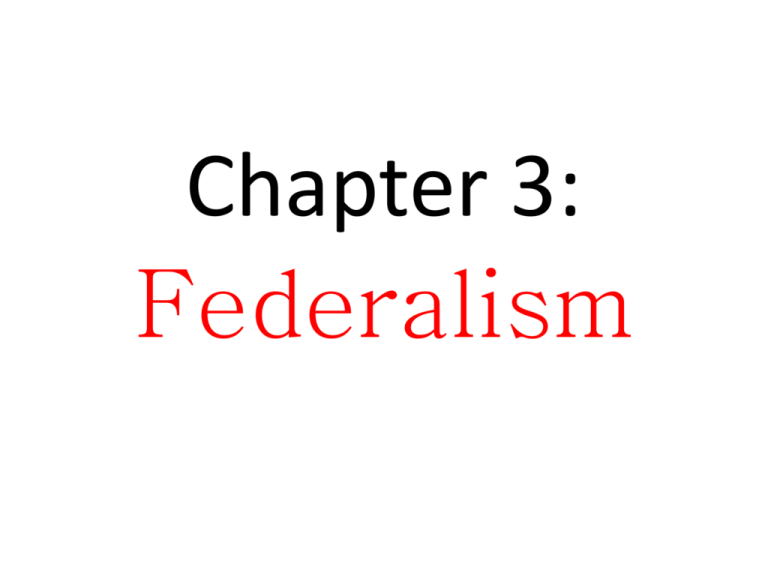
Chapter 3: Federalism FEDERALISM • two levels of government have formal authority over the same land and people • The division of power/authority between the state and national governments • Supremacy Clause: Article VI > makes the Constitution, national laws, and treaties supreme over state laws when the national government is acting within its constitutional limits – Judges in every state were bound to follow the Constitution Only 11 out of the approximately 190 countries of the world have federal systems. WHY FEDERALISM? • • • • Large size (land area) Large population (sub-units for efficiency) Diverse population (for diverse policy) Decentralizes power – with more decisions made in the states there are fewer sources of conflict at the national level – enhances judicial power, because the courts resolve all the disputes that arise • Decentralizes politics – with more layers of government, more opportunities exist for political participation, and there are more opportunities for interests to have their demands for public policies satisfied Unitary Government • all power resides in the central government • most governments in the world today are unitary governments 1. Great Britain, Japan • b. American states are unitary governments with respect to their local governments – 1. local governments get their authority from the states and can be created or abolished by the states – 2. states can also make the rules for local governments Confederation • the national government is weak and most or all of the power is in the hands of its components (for ex. individual states) a. the U.S. under the Articles of Confederation, the United Nations • the workings of the American system are sometimes called intergovernmental relations – a. Intergovernmental Relations: the entire set of interactions among the national, state, and local governments The Constitutional Basis of Federalism A. The word federalism is not mentioned in the Constitution B. 18th-century Americans had little experience in thinking of themselves as Americans first and state citizens second (strong state loyalty) C. The Division of Power • 1. the writers of the Constitution carefully defined the powers of state and national governments • 2. the writers favored a stronger national government, but states were restrained as vital components of government – a. states were given equal representation in the Senate, right to control elections, and right not to be divided into new states Enumerated Powers • powers of the federal government that are specifically addressed in the Constitution Article 1, Section 8 • The Congress shall have Power To lay and collect Taxes, Duties, Imports and Excises, to pay the Debts and provide for the common Defence and general Welfare of the United States; but all Duties, Imposts and Excises shall be uniform throughout the United States; [Altered by Amendment XVI "Income tax".] • To borrow money on the credit of the United States; • To regulate Commerce with foreign Nations, and among the several States, and with the Indian Tribes; • To establish a uniform Rule of Naturalization, and uniform Laws on the subject of Bankruptcies throughout the United States; • To coin Money, regulate the Value thereof, and of foreign Coin, and fix the Standard of Weights and Measures; • To provide for the Punishment of counterfeiting the Securities and current Coin of the United States; • To establish Post Offices and Post Roads; • To promote the Progress of Science and useful Arts, by securing for limited Times to Authors and Inventors the exclusive Right to their respective Writings and Discoveries; • • • • • • • • • To constitute Tribunals inferior to the supreme Court; To define and punish Piracies and Felonies committed on the high Seas, and Offenses against the Law of Nations; To declare War, grant Letters of Marque and Reprisal, and make Rules concerning Captures on Land and Water; To raise and support Armies, but no Appropriation of Money to that Use shall be for a longer Term than two Years; To provide and maintain a Navy; To make Rules for the Government and Regulation of the land and naval Forces; To provide for calling forth the Militia to execute the Laws of the Union, suppress Insurrections and repel Invasions; To provide for organizing, arming, and disciplining, the Militia, and for governing such Part of them as may be employed in the Service of the United States, reserving to the States respectively, the Appointment of the Officers, and the Authority of training the Militia according to the discipline prescribed by Congress; To exercise exclusive Legislation in all Cases whatsoever, over such District (not exceeding ten Miles square) as may, by Cession of particular States, and the acceptance of Congress, become the Seat of the Government of the United States, and to exercise like Authority over all Places purchased by the Consent of the Legislature of the State in which the Same shall be, for the Erection of Forts, Magazines, Arsenals, dock-Yards, and other needful Buildings; And 10th Amendment “the powers not delegated to the United States by the Constitution, nor prohibited by it to the states, are reserved to the states respectively, or to the people” Printz v. United States and Mack v. United States (1997) • Courts voided the congressional mandates of the Brady Bill saying you cannot force states to address particular problems and the national government cannot force states law officials to enforce a federal program Establishing National Supremacy • four key events have largely settled the issue of how national and state powers are related #1: The elaboration of the Doctrine of Implied Powers • McCulloch v. Maryland, 1819: the case that first brought the issue of state versus national power before the Supreme Court • This case (dealing with the idea of a national bank), the Supreme Court ruled that national policies take precedence over state policies: Chief Justice John Marshall wrote that "the government of the United States, though limited in its power, is supreme within its sphere of action" Elastic clause or implied powers: the national government has certain powers beyond their enumerated ones “To make all Laws which shall be necessary and proper for carrying into Execution the foregoing Powers, and all other Powers vested by this Constitution in the Government of the United States, or in any Department or Officer thereof” • Powers of the federal government that go beyond those enumerated in the Constitution - Congress has the power to "make all laws that are necessary and proper for carrying into execution" the enumerated powers • a. Elastic Clause: the final paragraph of Article 1, Section 8 of the Constitution • E.g. policies to regulate food and drugs, build interstate highways, clean up dirty air and water Interpretation of the ‘Necessary and Proper’ clause has been controversial, especially during the early years of the republic. • Strict constructionists interpret the clause to mean that Congress may make a law only if the inability to do so would cripple its ability to apply one of its enumerated powers. • Loose Constructionists, on the other hand, interpret the Necessary and Proper Clause as expanding the authority of Congress to all areas tangentially-related to one of its enumerated powers. • It is often known as the “Elastic Clause" because of the great amount of leeway in interpretation it allows; depending on the interpretation, it can be "stretched" to expand the powers of Congress, or allowed to "contract," limiting Congress. • In practical usage, the clause has been paired with the Commerce Clause in particular to provide the constitutional basis for a wide variety of federal laws The Preamble • “We the People of the United States, in Order to form a more perfect Union, establish Justice, insure domestic Tranquility, provide for the common defence, promote the general Welfare, and secure the Blessings of Liberty to ourselves and our Posterity, do ordain and establish this Constitution for the United States of America” • A unique aspect of the American system of government is that, while the rest of the world views the United States as one country, domestically American constitutional law recognizes a federation of state governments separate from (and not subdivisions of) the federal government, each of which is sovereign over its own affairs. • Sometimes, the Supreme Court has even analogized the States to being foreign countries to each other to explain the American system of State sovereignty. • However, each state's sovereignty is limited by the U.S. Constitution, which is the supreme law of both the United States as a nation and of each state; in the event of a conflict, a valid federal law controls. • As a result, although the federal government is recognized as sovereign and has supreme power over those matters within its control, the American constitutional system also recognizes the concept of "State sovereignty," where certain matters are susceptible to government regulation, but only at the State and not the federal level. #2: The definition of the Commerce Clause • “To regulate Commerce with foreign Nations, and among the several States, and with the Indian Tribes” • Gibbons v. Ogden, 1824: Supreme Court interpreted the clause very broadly, giving Congress the power to regulate interstate commerce, encompassing virtually every form of commercial activity. #3: The Civil War • a. The War settled militarily the issue that McCulloch had enunciated constitutionally • b. A war fought over state power v. national power – Federal Supremacy vs. States’ Rights #4: The struggle for Racial Equality • a. Brown v. Board of Education, 1954: Supreme Court held that school segregation was inherently unequal, therefore ‘unconstitutional’ • b. Southern politicians responded with "massive resistance" to the decision – Governor George Wallace of Alabama blocked the entrance of the school in an attempt to keep out black students • c. the conflict between the states and national government over equality issues was decided in favor of the national government The Little Rock Nine • Several segregationist councils threatened to hold protests at Central High and physically block the black students from entering the school. Governor Orval Faubus deployed the Arkansas National Guard to support the segregationists on September 4, 1957. The sight of a line of soldiers blocking nine black students from attending high school made national headlines and polarized the nation. • On September 9, Little Rock School District issued a statement condemning the governor's deployment of soldiers to the high school and called for a citywide prayer service on September 12. • Even President Dwight Eisenhower attempted to de-escalate the situation and summoned Governor Faubus to meet him. The President warned the governor not to defy the Supreme Court's ruling. • Woodrow Nilson Mann, the Mayor of Little Rock, asked President Eisenhower to send federal troops to enforce integration and protect the nine students. • On September 24, the President ordered the 101st Airborne division of the U.S. Army to Little Rock and federalized the entire 10,000 member Arkansas National Guard, taking it out of the hands of Governor Orval Faubus. States' Obligations to Each Other • 1. Full Faith and Credit - Article IV, Section 1, requires each state to recognize the official documents and civil judgments rendered by the courts in other states – a. Defense of Marriage Act: Congress said that states did not have to recognize gay marriages, even if they are legal elsewhere • 2. Extradition: States are required to return a person charged with a crime in another state to that state for trial or imprisonment • 3. Privileges and Immunities Clause: Article IV, Section 2, accords citizens of each state most of the privileges and immunities of any other state in which they happen to be – a. Exceptions: state residents pay cheaper tuition at state universities, only state citizens can vote in state elections, special taxes on hotel rooms for out of state people Dual Federalism • a system of government in which both the states and the national government remain supreme within their own spheres, each responsible for some policies Cooperative Federalism • a system of government in which powers and policy assignments are shared between states and the national government • a. They may share the costs • b. They may share the administration • c. Federal Guidelines: most federal grants to states come with strings attached (for ex. Drinking Age) • d. They may even share the blame for programs that work poorly Fiscal Federalism • the pattern of spending, taxing, and providing grants in the federal system • 1. fiscal federalism is the cornerstone of the national government’s relations with state and local governments • 2. the national government has a powerful source of influence over the states – money Grants-in-Aid • federal funds are funds appropriated by Congress for distribution to state and local governments • a. they are the main instrument the national government uses for both aiding and influencing states and localities – 1. federal aid accounts for about 1/5 of all the funds spent by state and local governments and for about 17% percent of all federal government expenditures #1: Categorical Grants • federal grants that can be used only for specific purposes, or categories, of state and local spending • there are two types of categorical grants • 1. Project Grants: federal grants given for specific purposes and awarded on the basis of the merits of applications (the most common type of categorical grant) • 2. Formula Grants: federal grants distributed according to a formula specified in legislation or in administrative regulations #2: Block Grants • federal grants given more or less automatically to states or communities to support broad programs in areas such as community development and social services – States have the discretion in deciding how to spend the money


